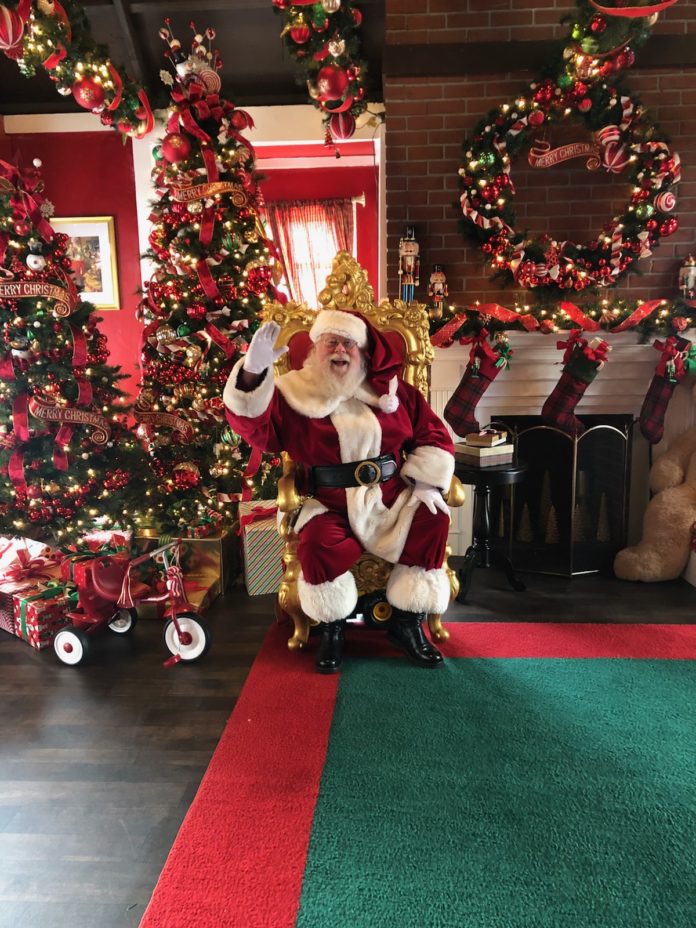This holiday season, Rich was replaced by a Santa who, instead of posing for a photo with the dressed-up youngsters, is waving from afar while riding on a trolley passing through the shopping center.
“They were originally going to have a sleigh set up and put a piece of plexiglass to separate Santa, but I guess they are not able to do it,” Rich said, adding that his other gig at Curacao’s department stores in South Gate, Westlake, Lynwood and Panorama City was also canceled for safety concerns, and he’s “out two weekends of work.”
Mall owners’ reluctance to bring back longstanding holiday traditions comes as no surprise right now. L.A. County remains in the state’s toughest tier of Covid-19 restrictions because the disease is widespread. In purple tier counties, including L.A., Gov. Gavin Newsom has allowed indoor shopping centers to remain open, but they must limit store occupancy to 20% and close common areas and food courts.
Santa visits at shopping centers are part of an “economic blueprint that has driven commercial Christmas for generations,” according to Ric Erwin, who’s serving as the chairman of Fraternal Order of Real Bearded Santas, a national association with some 600 members.
“The foot traffic that comes to see Santa percolates out to the rest of mall, and the mall (provides a customer) stream for the Santa’s set as well,” Erwin said. “It’s a symbiotic relationship.”
It appears that the pandemic only reaffirmed the codependency that dates to the 1890s.
About one-third of some 200 Santas that responded to Erwin’s online poll in late October said they are not working this year. He’s among them.
“We lost my father-in-law in May, and although Covid didn’t kill him, Covid did leave him stranded all alone in a hospital bed when he died. I promised my mother-in-law and my wife that I would take zero chances of bringing the virus into this home,” Erwin said. “When things did not get better, I decided to activate the escape clause that I’ve been inserting in my contract since June that said in-person Santa events this year were contingent on both a safe reliable vaccine available by Thanksgiving and a proven therapeutic in case all prophylactic measures failed. By early October, I triggered that clause in every contract and canceled my entire season.”
Likewise, the foot traffic at malls nationwide is down while online purchases are picking up.
Ecommerce sales in the United States totaled about $60 billion from Thanksgiving through Cyber Monday, a 22% increase compared to the same period in 2019, according to data from San Francisco-based Salesforce.com Inc. Meanwhile, the National Retail Federation reported that the number of in-store shoppers on Black Friday dropped by 37%.
Most local malls saw similar patterns during the busiest part of the holiday shopping season.
“Covid restrictions and lack of doorbusters along with retailers extending their Black Friday sales created a lighter traffic day than in previous years,” said Michael de Leon, general manager at Burbank Town Center.
De Leon added that the “new local guidelines and restrictions may change where Santa will be located and how set operations will be handled,” and will include daily temperature checks and symptom-screening protocols for Santa as well as requiring reservations and social distancing for taking photos.
Maria Mainville, director of strategic communications at Taubman Co.’s Beverly Center, said her team was “very pleased with the shopper turnout, particularly because we felt that the mandates to limit capacity might discourage shoppers from coming altogether.”
Santa’s appearances at the high-end center is scheduled for the weekends and is limited to “casual stroll around to say hello to customers.” The mall patrons can also reserve a one-on-one home visit with Santa, who can show up at the door with cookies and a personalized note or a gift from one of Beverly Center’s retailers.
“Right now, communities are craving a sense of normalcy, and there is nothing more beloved than the long-standing tradition of seeing Santa at the mall over the holiday season,” Mainville said.
Molly Unger, vice president of shopping center management for Unibail-Rodamco-
Westfield, which operates Westfield Century City, Westfield Culver City, Westfield Topanga and The Village, Westfield Santa Anita and Westfield Fashion Square, said the shopping centers “saw steady foot traffic throughout the day and through the weekend.”
“To best meet our guests’ needs, we provided center occupancy levels on our website so everyone could plan to come when they were most comfortable, and offered a number of additional services, like Line Pass, curbside pickup and touchless parking,” Unger said.
Santa was there too, but via “self-service, contact-free” photo setups.
Macerich Co., a Santa Monica-based real estate investment trust that operates Santa Monica Place, Los Cerritos Center, Lakewood Center and The Oaks, closed its properties on Thanksgiving. It did not provide shopper traffic data but said Santa and his visitors will be wearing masks and practicing social distancing.
“People are hungry for things in life that feel ‘normal’ and comfortable environments for holiday shopping, (for) places that have been thoughtfully adapted for today’s health concerns … (which is) exactly what Macerich is delivering in 2020,” Olivia Bartel Leigh, Macerich executive vice president for portfolio operations and people, said in a statement.
Macerich reported a net loss of about $22.2 million in the third quarter that ended Sept. 30, compared to a net income of $46.4 million during the same period last year. It also said rent collection rate was at 80%, up from approximately 61% in the second quarter of 2020.

